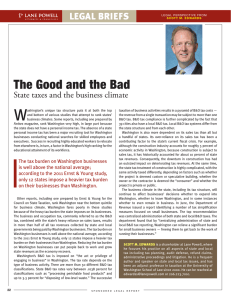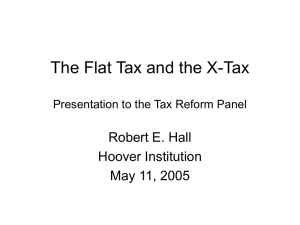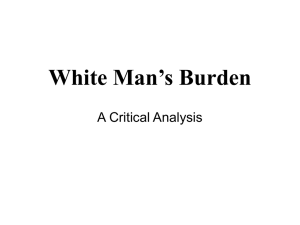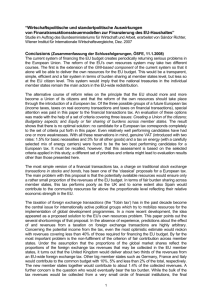Document 13726019
advertisement
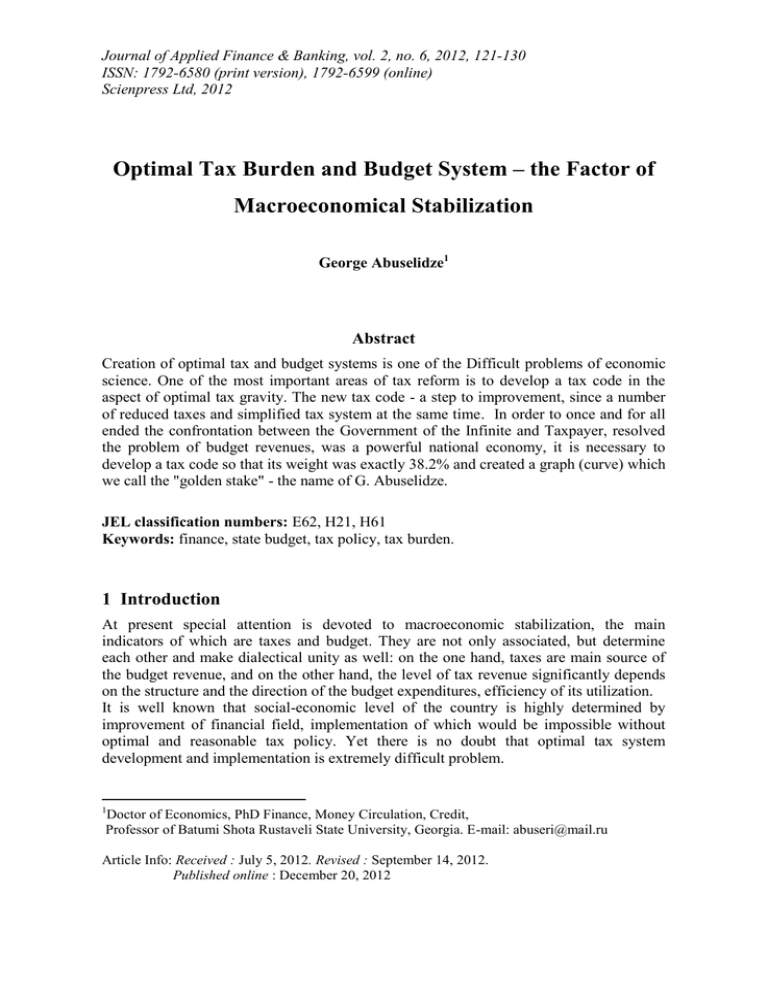
Journal of Applied Finance & Banking, vol. 2, no. 6, 2012, 121-130 ISSN: 1792-6580 (print version), 1792-6599 (online) Scienpress Ltd, 2012 Optimal Tax Burden and Budget System – the Factor of Macroeconomical Stabilization George Abuselidze1 Abstract Creation of optimal tax and budget systems is one of the Difficult problems of economic science. One of the most important areas of tax reform is to develop a tax code in the aspect of optimal tax gravity. The new tax code - a step to improvement, since a number of reduced taxes and simplified tax system at the same time. In order to once and for all ended the confrontation between the Government of the Infinite and Taxpayer, resolved the problem of budget revenues, was a powerful national economy, it is necessary to develop a tax code so that its weight was exactly 38.2% and created a graph (curve) which we call the "golden stake" - the name of G. Abuselidze. JEL classification numbers: E62, H21, H61 Keywords: finance, state budget, tax policy, tax burden. 1 Introduction At present special attention is devoted to macroeconomic stabilization, the main indicators of which are taxes and budget. They are not only associated, but determine each other and make dialectical unity as well: on the one hand, taxes are main source of the budget revenue, and on the other hand, the level of tax revenue significantly depends on the structure and the direction of the budget expenditures, efficiency of its utilization. It is well known that social-economic level of the country is highly determined by improvement of financial field, implementation of which would be impossible without optimal and reasonable tax policy. Yet there is no doubt that optimal tax system development and implementation is extremely difficult problem. 1 Doctor of Economics, PhD Finance, Money Circulation, Credit, Professor of Batumi Shota Rustaveli State University, Georgia. E-mail: abuseri@mail.ru Article Info: Received : July 5, 2012. Revised : September 14, 2012. Published online : December 20, 2012 122 George Abuselidze In the concept of tax burden the important fact is the connection of tax burden with the economic activity and production capacity. tax burden influences not only the budget revenues but investments, demand and supply, prices and others. All this, has direct as well as indirect influence on the economic activity and production capacity. The influence of tax burden on budget tax revenues and production capacity can be realized in two different ways. On one hand tax burden has influence on production technologies, effective usage of resources that accordingly will be depicted on the production capacity and, on the other hand, the change of tax burden has influence on budget tax revenues that will be depicted on the economic activity. Therefore, creation of optimal tax and budget system is one of the most difficult problems of economics. Tax and budget system must be developed so that private entrepreneurial activity will not be depressed by the increase of budget revenue. Optimality of tax and budget policy is defined by transparency and impartiality of its scope in budget formation and successful regeneration of revenue, utilizing them in the purpose of stabilization of economy and implementation of state interests in the future. Tax system perfection is the most important basis of economic development. Despite the development level there is no country on the world where they don’t argue on the hardship of budget system, its management policy and tax burden. Although foreign experience clearly states in case of too liberal and a tax burden the economy functions ineffectively. Accordingly, it is very important to calculate tax burden correctly. The actuality of studying tax problems is also conditioned by the fact that, today negative tendencies of tax policy are revealed in the economic development of states. 2 Preliminary Notes In fact, the conditions can be regarded as optimal tax burden, when favorable economic environment is achieved for better economic functioning and business activities of the country are extended. It means that taxes must be optimal both for the State as well as for individual business owners. Such is a condition, when both budget revenue and private investments are increasing at the same time. Then I think the fair will be set for approval - the justification for the amount of fees will be good and best for the country: what should be public and the government's approach to the solution of this problem. Besides, the aim of tax reforms implemented in developed countries is determination of tax rate optimum, which means to work out tax policy encouraging business development and increasing budget revenue. After all of the foregoing, it will be to formulate a valid opinion of cargo (in burden), which exists in any economy. "The tax burden in the economy is the financial (resource) burden (burden), which will push the economy to the legal sector as a collective consumption good production for the state's coercive redistribution of national income, as provided by law to collect the Tax due. It is usually higher than the optimum size of development is characterized by a trend. We belong to the group, which considers establishment of the optimal tax burden as the most realistic and effective way for correct tax policy formation. The only difference is that this is possible only if based on mathematical truth. Optimal Tax Burden and Budget System 123 Therefore, for the approval of all above mentioned, draw a straight line ox and take a point a (see the chart). O a x Write the chart as equals: x a a xa , (1) Where X is maximum tax rate – 100%, a – maximum tax revenue of the budget, x-a – optimal tax rate. Equals we introduced may seem strange and ridiculous, as actually seems strange that “ratio” of the whole section to its part is the same as “ratio” of this part to whole section minus this part. But let us continue and write the equals as quadratic equation: x2 – ax = a2, (2) To check correctness put the answer in the formula (2) Thus, optimal tax rate is x-a=100-61.8=38.2% Thus, in the case of taxation at the rate of 38.2% budget revenues will grow, and the tax payer get the source, which allows them to expand their business and create new jobs, which will ultimately impact on the economic development of the country. This study was conducted in Georgia, is presented in my article and dissertations, where we have created this burden (38.2%) and schedule (curve), which we call the "Golden share" - the name of the G. Abuselidze. 3 Literature Review The world economists, philosophers and statesmen of all times and epoch practically acknowledge special significance of taxes. According to so called pessimistic concept (pessimistic concept, www.wisegeek.com/what-is-keynesian-economics.htm) it is impossible to establish any dynamic regularities in this process, as due to incidental circumstances various tax payers bear different tax burden. Proudhon stated that all taxes finally focus at final consumers of products and cause reduction of their income, disproportions and losses in economics, injustice in society (Pierre-Joseph Proudhon, General Idea of the Revolution in the Nineteenth Century). 124 George Abuselidze According to optimistic production (Dems-Determined-to-Crack-Gop-No-TaxPledge.(2012). http://thefiscaltimes.com) - contrawisely, all the taxes finally evenly distribute between all tax payers in direct proportion to goods consumption and utility. Mathematic concept based on theory of marginal utility of production which founders the famous scientists Bohm-Bawerk, Walras etc. were (Kugaenco, Belyanin, 1999), illuminated research of this problem and use for its explanation such economic categories, as demand, supply and price, i.e. elasticity of demand and supply. They consider relation of these categories to taxes. Statistic concept tries to explain the named phenomena by the way of fundamental analyzing of the statistic data received resulted multiple statistic observation. According to E. Atkinson and J. Stiglitz (Atkinson, Stiglitz, 1995), payment of taxes results reduction of individuals’ incomes. They really grow poorer and have to suspend retirement, reduce spare time on cost of growing working hours etc. Adam Smith regarded taxes as the index of freedom for tax payers, but for Motesque nothing and no one needs such a wisdom and mind as defining tax size and that part, which stays with a tax payer. Adam Smith (Smith, 2011) wrote about the necessity of existing optimal tax policy in the country: “The owner of the capital is actually the citizen of the whole world and doesn’t represent the property of one country. He will immediately leave the country with undesirable tax condition and invest his capital in the country where he will be able to run his business and property without pressure”. Since earliest times, many famous scientific economists, including Nobel Prize winners, moved into front line the question of decreasing tax burden in the country that would encourage economic activity and increase tax revenue of the budget. The principal factors determining extent of impact of taxation pressure on economic activity and output include profitability of production in the sector, competition severity, manufacturing and sale of concrete products, industrial specificity of sectors, regions and spheres, general social and politic condition in the country, incomes of the various sections of population and their economic status. 4 Methods of Research Deduction, Synthesis, comparative analysis of scientific literature, statistical analysis, Historical approach. 5 Survey According to the tax theory of well known American economist A. Laffer and supplyoriented theory of his followers – M. Burns and G. Stein, driving force of economy is the interest of business owners and increase of tax rates to specified level will cause growth of revenue, but its further increase is economically unjustified, whatever the motivation is. Beyond this limit (the so-called critical area) revenue starts to diminish, because taxes burden the business. This view is known as Laffer Effect and is used as a proof that decrease of tax rates finally results in increase of total tax contribution. Foreign researches performed in this respect reveal that while taking into account time factor it is very importance, whether average single tax increases or decreases. Optimal Tax Burden and Budget System 125 Eugenie Balatsky introduces the term “aftereffect” according to which rising of average single tax upper the concrete value causes reduction of budget revenues several years later. For this effect A. Dagaev (Dagaev, 1995, 2001) uses the term of tax “hysteresis”, as Laffer effect exhibits only after several years. That is why words order – Laffer effect with tax “hysteresis”, or Laffer effect with aftereffect is correct. According to the economic theory of supply (the so-called theplasiders) with the view of resolving the problem of country’s economy tax decrease is necessary. With low tax rates business owners have opportunity to accumulate, which provides complete utilization of business potential and increase of gross domestic product of the country. Researches performed in respect to the countries of post-soviet capitalism revealed principal potential of existence of Laffer effect. It is not less important, that many economists enjoying world recognition put a question of reduction of tax load just in respect of such countries (ex., Nobel prize winner in Economic, Professor Gary Becker (Becker G.S. 1998, August 3) towards Georgia and Harvard University Professor Jeffrey Sachs towards Ukraine). As they consider, reduction of tax load promotes growth of economic activity and growth of budget revenues. It should be necessarily remarked that reduction of the rates of some kinds of taxes (what naturally, will be expressed through reduction of average single tax) causes growth of budget revenues in Georgia. Economy of post-soviet capitalism countries, in contract to economy of the other countries has one typical important feature: great reserve of unloaded production facilities, what from its side gives potential of significant expansion of production without big investments, what presents a precondition for appearance of Laffer effect. For the countries being in the process of transformation of post-soviet economy it is very important that reduction of tax rates for the purpose of reduction of tax load is not limited with stimulation of supply, as it simultaneously promotes stimulation of demand as well. This approach offered by us is called “Laffer-Keynes synthesis”, which makes a methodological basis for so called tax therapy promoting development of post-soviet capitalist countries. According to Keynesian approach, reduction of tax rates causes growth of consumption: increase of consumers expenditure in the sort-time period causes growth of goods and service demand, i.e. expansion of production and job growth ; besides, decrease of reserves caused with growth of consumption sharpens competition between investors, what finally causes rise of interest rate, consequently prevents domestic investments and stimulates foreign capital importation. For developed countries economy such an effect is naturally negative. As for economy being in the process of post-soviet transformation, it is evidently desired: first of all, lessening of tax load promotes release of the sums needed for loading of production facilities. Besides, for the purpose of production of competitive products in terms of out-of-date equipment and technology just foreign investments are needed. A part of economists prejudice correctness of above mentioned postulates of theory of supply. For example, G. Mankiw considers with theory to such practical extent that in his well-known book “Principles of Economics”, he uses the episode, when in 80s of XX century a group of economists (including Laffer) recommended to the presidential candidate R. Reagan to reduce income profit for the purpose of economic activation and increase of tax revenues, for illustration of “charlatan and eccentric” economists ( G. Mankiw, 2000, p.43). We must note that in our opinion acute reduction of tax burden is not a cure and not always leads to growth of the tax base and the budget revenue. 126 George Abuselidze Authors of another approach consider decrease of tax rates as a salvation from budget deficit. Professors from Ohio University of the USA Dowl Mallaway and Richard Vedder came to a conclusion that mean rates of federal taxes and deficit in federal budget are actually correlated. The higher tax rates the higher budget deficit is. Using the method of complex analysis they found that tax increase by 1 USD results in 1,58 USD growth of government expenditure, which means 0.58USD growth of deficit (Гисаев А. Б. 2003, С.87). Although tax increase seems to be the easiest way of elimination or reduction of budget deficit, but actually it is not true. Therefore, with the view of elimination of budget deficit there is no need in higher tax rates or introduction of new taxes. Considering regional features and specific tasks, it is reasonable to differentiate tax rules, profit rates and objects of taxation. Unfortunately, most of the authors do not pay attention to the question of different tax regimes and rates influence on macroeconomic balance and employment level. However, we disagree with the Laffer-Keynes theory postulates, considering that introduction of optimal mean tax rates only is not able to increase employment level, initiate establishment of a new balance and mobilization of maximal tax revenue in the budget. In fact, the conditions can be regarded as optimal tax burden, when favorable economic environment is achieved for better economic functioning and business activities of the country are extended. It means that taxes must be optimal both for the State as well as for individual business owners. Such is a condition, when both budget revenue and private investments are increasing at the same time. In respect to taxation pressure peculiarities of economic activeness and output may be explained by means of balancing of positive and negative effects. Hereinafter the effects promoting growth of economic activeness and output in case of increase of taxation pressure and those preventing such growth in case of decrease of taxation pressure we call “positive”, and vice versa: the effects preventing growth of economic activeness and output in case of increase of taxation pressure and those promoting such growth in case of decrease of taxation pressure we call “negative”. The group of positive effects may include the effect of creation of economic environment (or economic ability of state) and the effect of benefits. The effect of creation of economic environment suppose that growing of taxation pressure up to the optimal level – 38,2% (Abuselidze, 2005) extends financial abilities of state and it performs its economic function better (please, find Abuselidze curve) Figure №1. Figure 1 Optimal Tax Burden and Budget System 127 This effect is positive for output, as in conditions of growing tax revenues, first of all supply from public sector itself grows by means of creation of more public wealth and services, and, secondly, state improves business environment, what is very important for promotion of growth of economic activeness in private sector . The effect of benefits defines direct influence of taxes on individuals’ behaviour. So, the effect of benefits promotes economic activeness in case of growing of taxation pressure up to the optimal level. The group of negative effects includes the effect of replacement and financial effect. Existence of the effect of tax replacement is provided with that some kinds of business are not taxable, besides those taxable are liable to various rate taxes. When tax rates grows over the optimal pressure, resulted the effect of replacement business transfers from taxable spheres to tax-free spheres or from the spheres of heavy taxes – to the spheres of lower taxes. The individuals actively seek and often find the ways to avoid taxes partly or wholly. Such ways of avoiding taxation lead to reduction of budget revenues (Abuselidze, 2005). The same result is received resulted financial effect. This effect originates, when the same business may be compensated in various forms and correspondingly the rate may vary. Classical example of influence of this effect is the case, when for the purpose of avoiding grown tax the business entities shift taxes onto each other and transfer to shadow economy. That’s why, when the state decides tax burden, changes some tax, it has to define who really undergoes this tax and only after that it must be decided to change or not to change, establish or not to establish and minimize or maximize it. 6 Conclusions and Recommendations In the optimal taxation pressure concept relation of taxation pressure to economic activeness and output is especially important. According to this concept, at critical values of taxation pressure t=0 and t=1 activeness drops to minimum; at t=0 – because state will not have any revenues, nor fulfill its economic functions, and at t=1 – because at 100% taxation no one wishes to work out any legal revenues. At the same time, providing this concept, there are levels, differ from taxation pressure (t=0 and t=100), namely t 1=50% (Laffer) and t2=38,2% (Abuselidze), when economic activeness and output differ. Besides, role and importance of these rates are determined with correlation of: a) taxation pressure and output; b) budget revenues and economic activeness. Let us assume, that at the initial stage balance of output and economic activeness is at point F and it is corresponded with tax rate t. Let us say that due to some circumstances state charge grew to some value. In other equal conditions this change will cause growing of economic activeness and correspondingly curve moves to the new position. In such situation, for the purpose of achieving the new balance, simultaneously with grown expenses state has to rise t value up to t2. The matter is that at F point of the initial balance economy is on the ascending part of the curve of aggregate supply. In such case, among the effects originated resulted rise of t the sum of the effect of creation of output promoting environment and the effect of revenues prevail. That is why, ironically enough, rise of taxes up to t2 will promote growing of recourses supply. In circumstances of grown quantity of using recourses available the aggregate output will grow and balance will be achieved at point F1(Figure №2). 128 George Abuselidze Figure 2 The different situation takes place, when the initial balance point is at E. This latter is on the descending part of output and aggregate supply, where prevailing role belongs to negative effects of taxes (effect of replacement and financial effect). Certainly, in such conditions lowering of taxation pressure is a natural way of economic activeness stimulation and growth of output. That is why, in this hypothetic situation, if state reduces t value from t1 to t2, then economy will manage to transfer to the new balance at E1 and satisfy the grown aggregate demand (Figure №3). Figure 3 In spite of curves shifting fiscal points t1 and t2 remain unchanged, although maximum values of output and economic activeness determined by these points do change (Figure №4). So, the level of balance of economic activeness and output depends on optimal taxation pressure t2=38,2%. Figure 4 Based on the abovementioned, we can conclude: if we want to put an end to the confrontation between the government and business owners, to develop production, to Optimal Tax Burden and Budget System 129 settle the problem of the budget revenue and, eventually, create powerful economy, we need to elaborate the Tax Code, with its burden equal to exactly 38.2%. ACKNOWLEDGEMENTS: During the twenty-first century, a special emphasis is given to macroeconomic stabilization. Unfortunately, many economists miss the problems associated with the influence of the tax burden and the level of employment for macroeconomic stabilization. Based on them, research is very important from the point of view of research and practical point of view. We offer optimal burden of 38.2% in economic science, this burden will allow the budget to receive the maximum income and receive further development. Therefore, we believe that this article deserves attention and deeply thank the reviewers who gave very positive feedback on my manuscript entitled: Optimal tax burden and budget system – the factor of macroeconomical stabilization. References [1] [2] [3] [4] [5] [6] [7] [8] [9] [10] [11] [12] [13] [14] G. Abuselidze. The prospects of modern budget revenue in the aspect of the new Tax Code. International refereed and reviewed scientific and practical Journal of “Social Economy”, Tbilisi, 1, (2005), ISSN-1512-1194. G. Abuselidze, Peculiarities of formation and functioning of Georgian budget system in transient period, Author's abstract of dissertation, Tbilisi, (2005) 16. G. Abuselidze, Features of Formation and Functioning of Budgetary System of Georgia at the transitive stage, “Publishing House of Science”, tb., 2006, ISBN99928-0-900-X. I. Ananiashvili. Taxes Influence the Aggregate Supple. International refereed and reviewed scientific and practical Journal of tha Faculty of Economics and Business, iv. Javakhishvili State University of Tbilisi, 1, (2009), ISSN-1987-5789. Atkinson E.B., Stiglitz Dzh. E.Lektsii according to the economic theory of public sector, M, Aspect Press, (1995), 48-49. Balatsky E.V.Analys of Influence of tax loading on economic growth with the help is production – institutional functions. Problemi of forecasting. 2, 2003, page 15. Becker G. S. A Free-Market Winner vs. a Soviet-style Loser. Business Week, august 3, (1998). Becker, G.S. _ Human behavior: an economic approach. Selected works on economic theory. Гер. from English. M., 2003, 672 G. Mankiw, Principles of Economics. Tbilisi, Diogenes, (2000) 43. A. Jibuti. Optimal tax rates as a basiss for development of the economy. International refereed and reviewed scientific and practical Journal of tha Faculty of Economics and Business, iv. Javakhishvili State University of Tbilisi, 4, (2009), ISSN-1987-5789. Georgia: Tax Policy Review. Washington, IMF, 2010. Lessons of Tax Reform. Washington, The World Bank, 1991. Tax Policy Handbook. Ed. By P. Shome. Washington, IMF, 1995. McGuire R., Van Cott T. N. The Confederante Constitution, Tariffs, and the Laffer Relationship. Economic Inquiry, 3(40), (2002). 130 George Abuselidze [15] Dagaev A.A. Investments and Tax Policy (Contours of Renewable Paradigm. Economist, 10, (1995). [16] Dagaev A.A. Will Tax Reduction Cause Growth of Investments? World Economy and International Relations, 1, 2001. [17] http://www.wisegeek.com/what-is-keynesian-economics.htm [18] http://wn.com/Pierre-Joseph_ProudhonGeneral_Idea_of_the_Revolution_in_the_Nineteenth_Century/#/book [19] http://thefiscaltimes.com/Artcles/2012/03/01/Dems-Determined-to-Crack-Gop-NoTax-Pledge.aspx#page1 [20] Adam Smith, Research, An Inquiry into the Nature and Causes of the Wealth of Nations., Tbilisi, 2011, ISBN: 978-9941-18-052-1. [21] David Ricardo, Principles of Political Economy and Taxation, Tbilisi, 1937. [22] Kugaenco A. A., Belyanin M.P. Taxation Theory, Moscow, 1999.
